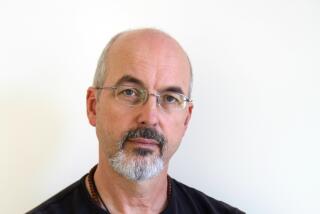Reflections on ignorance and bliss
- Share via
As the clock ticked past 1 a.m., filmmaker Apichatpong Weerasethakul was still in his Thailand studio working on a new set of subtitles to his latest film, “Syndromes and a Century.” So engrossed was he in the task that a scheduled phone call with an interviewer came to him as a blurry surprise.
It’s an oddly appropriate reaction given that reverie and rupture figure so prominently in his films. Regarded widely as one of the freshest cinematic voices of our time, Weerasethakul makes films that are as beguiling as they are difficult to pin down. He also creates less widely circulated video installations for gallery spaces, the latest of which Los Angeles audiences can see beginning today at REDCAT.
Titled “Unknown Forces,” the installation consists of a four-screen video projection; taking up one side is footage of a pickup truck rolling down a highway, with passengers in the back. Ostensibly laid back, the scene in fact references the population of itinerant construction workers in Thailand, on whose backs the country’s real estate boom is built. The installation is a tribute to these workers, Weerasethakul said, as well as an allegory about the country’s political history.
“We are under a certain kind of pressure -- something we don’t understand and, at times, don’t realize. It’s the kind of forces we never question,” Weerasethakul said. For the peripatetic workers (“who never question where they are going day to day”), commerce is the dictating force. For the people of Thailand, it is the persuasion of politics.
The military coup in that country overthrowing Prime Minister Thaksin Shinawatra last year provided the initial spark. “From the past year, Thai politics [have] crept into my personal life, and [with] many others that I know,” Weerasethakul explained, saying that “Unknown Forces” is the first in a series of works that will deal with the topic. “I tried to make sense of our ruling system. Then I realized nothing much has changed from several hundreds of years ago, and we are living in such a barbaric society. I woke up one morning and started this conversation with my partner. I felt saddened by the fact that suddenly I didn’t feel free.”
The outcome is not simply powerlessness but a sort of blissful ignorance, he said. “I am quite happy living here. At the same time, this ignorance doesn’t only apply to construction workers; it applies to me too. And I am trying to incorporate this feeling of ignorance into the installation -- as happiness.”
That notion of nuanced joy is also a touchstone in his films, in which happiness figures as the very thing that’s bound to be lost -- leaving behind only memories, those obscured reminders of what once was. In conjunction with the exhibition, REDCAT is scheduled to host a program of film screenings in June consisting of Weerasethakul’s first three full-length films and a slate of recent shorts. (“Syndromes and a Century” is scheduled to premiere at the Los Angeles Film Festival the same month.)
Mixing fictional and documentary footage, his debut film, “Mysterious Object at Noon” (2000), deploys the surrealist concept of the Exquisite Corpse to tell a chain-linked story written by a succession of Thai women. In “Blissfully Yours,” his second film and winner of the Un Certain Regard award at Cannes in 2002, three people find refuge from the everyday in an idyllic forest. It is a languid tale dotted with hints of violence and existential alienation. Sex, naturally, seems to be the only therapy -- and there’s lots of it here. “Tropical Malady” (2004) is the sum of two seemingly different stories: a budding romance between a soldier and another man, and a soldier roaming through a moonlit forest in search of his deceptive prey. The film is a perfect expression of the love/loss dichotomy -- the first part all sugar-sweet Eden, next a literal horror.
Weerasethakul’s solo video exhibition, from the curatorial point of view, has been some six years in the making, said Eungie Joo, director and curator for the gallery at REDCAT. As an independent curator in 2001, Joo co-curated a show for San Francisco’s Yerba Buena Center for the Arts, where Weerasethakul was one of the artists. She has followed his film and video work ever since. Last October, the filmmaker was invited to visit CalArts -- and plans for a REDCAT exhibition were hatched. “I think the issues of labor and politics in the region and in Thailand have clearly been impacting his work, and the narratives and non-narratives within his existing feature films. I think this [piece] is a kind of extension of the conversations that have already begun,” Joo said.
It’s a conversation Weerasethakul is comfortable with in either form. “I don’t differentiate that much between film and video installation. It’s more that I have more freedom in visual art because I can focus and explore more on abstract ideas that I cannot explain,” he said. “At the same time, I am using the same crew and equipment.”
He often approaches both art forms, he said, simply by going up to people he finds interesting and letting the camera roll. All in all, “I am just attached to connecting with people,” Weerasethakul concluded.
More to Read
The biggest entertainment stories
Get our big stories about Hollywood, film, television, music, arts, culture and more right in your inbox as soon as they publish.
You may occasionally receive promotional content from the Los Angeles Times.










